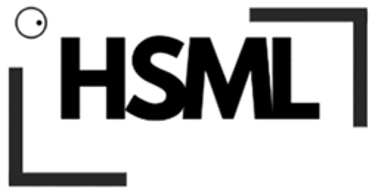Publications & Proceedings
Abstract
In 2020, Ireland missed its EU climate emissions target and, without additional measures, will not be on the right trajectory towards decarbonisation in the longer 2030 and 2050 challenges. Agriculture remains the single most significant contributor to overall emissions in Ireland. Without effective mitigating strategies, agricultural emissions have continued to rise. The review aims to explore current research conducted in Ireland regarding environmental modelling within agriculture to identify gaps for further research. 10 models were selected and reviewed regarding modelling carbon emissions from agriculture in Ireland, the GAINS (Air Pollution Interactions and Synergies) model used for air pollutants, the JRC-EU-TIMES, (Joint Research Council-European Union-The Integrated MARKAL-EFOM System) and the Irish TIMES model used for energy, the integrated modelling project Ireland (GAINS & TIMES), the environmental, economic model ENV-Linkages and ENV-Growth along with the IE3 and AGRI-I models. The review found that data on greenhouse gas emissions for 2019 reveals that emissions can be efficiently lowered if the right initiatives are taken. More precise emission factors and adaptable inventories are urgently needed to improve national CO2 reporting and minimise Ireland's agricultural sector’s emissions profile. The Climate Action Delivery Act is a centrally driven monitoring and reporting system for climate action delivery that will help determine optimal decarbonisation from agriculture in Ireland. Multi-modelling approaches will give a better understanding of the technology pathways required to meet decarbonisation ambitions.
Abstract
There may be unrecognised environmental and economic benefits in cultivating industrial hemp for CO2 sequestration in Ireland. By using a Systems Thinking approach, this study aims to answer how industrial hemp, which can sequester between 10 tonnes (t) to 22 t of CO2 emissions per hectare, has been helpful towards carbon sequestration efforts in Ireland. A mixed-methods design combining qualitative and quantitative secondary material is used to inform Behaviour over Time Graphs (BoTGs) to illustrate the data from 2017 to 2021. In 2019 at its peak of hemp cultivation in Ireland the total CO2 emissions from agriculture was 21,156.92 kilotonnes, and the total land cultivated with hemp was 547 hectares which represented an estimated 0.0079% of total land use and 0.011% of agricultural land use. Based on a sequestration rate of between 10 t and 22 t of CO2, industrial hemp had the potential to remove between 5470 t and 24,068 t of CO2 in 2019. The total amount of estimated CO2 sequestrated between 2017 and 2021 was between 14,660 t and 64,504 t of CO2. This represents an estimated contribution in carbon tax equivalent of between €348,805 and €1,534,742, respectively.
Abstract
This study explores how OpenAI’s ChatGPT can enhance the El Farol Bar Problem, a classic Agent-Based Model (ABM) in game theory, using NetLogo to aid in educational contexts. By simulating an Irishman, a Scotsman, and an Englishman, ChatGPT enables non-programmers to model complex agent behaviours and decision-making processes through natural language, making ABM accessible for students and researchers. ChatGPT facilitates scenario generation, natural language processing, and data interpretation, allowing users to adapt the El Farol Model in diverse ways to study cultural decision-making styles and collective behaviours. This innovative approach allows for better ABM learning, problem-solving, and scenario exploration.
Abstract
The research aims to identify System Dynamics courses available at the 3rd level in Ireland and will explore associated research undertaken within this modelling method. This will provide an understanding of the existing research conducted in Ireland and identify potential gaps for future research opportunities. A thematic analysis synthesising System Dynamics modelling research in Ireland was developed for the papers extracted. This provides for a new interpretive schema and configuration. The research found that undergraduate and postgraduate level courses in computational and mathematical modelling are available in higher education institutions in Ireland. Still, no exit degree courses are available by name, i.e., System Dynamics modelling. Skills in this modelling paradigm are challenging to find and will be required to build a qualified workforce for the future. Stand-alone System Dynamics, exit degree courses, may be needed for a contemporary curriculum design and the delivery of effective STEM education in Ireland.
A State-of-the-Art review: Ireland, a model state?
Sinéad M. Madden, Alan Ryan, Patrick Walsh
International Conference of the System Dynamic Society | Bergan | 2020
Conference paper
https://proceedings.systemdynamics.org/2020/papers/P1284.pdf
This review examines the state-of-the-art hybrid simulation modelling and mixed methodologies, focusing on their role in reducing greenhouse gas emissions and advancing a circular green economy in Ireland by 2050. Ireland has missed its 2020 EU climate targets and faces significant challenges in achieving its 2030 and 2050 decarbonisation goals. To address these challenges, hybrid simulation techniques, combining System Dynamics (SD), Agent-Based Modelling (ABM), and Discrete Event Simulation (DES) offer innovative solutions. The review highlights the application of these methodologies in environmental and economic models, such as the GAINS and Irish TIMES models, which have been used to inform policy decisions. This study also underscores the importance of integrated policy analysis that considers air, climate, economy, and health impacts and calls for further research into using hybrid simulation modelling to enhance Ireland’s policy decision-making in pursuit of sustainability goals.
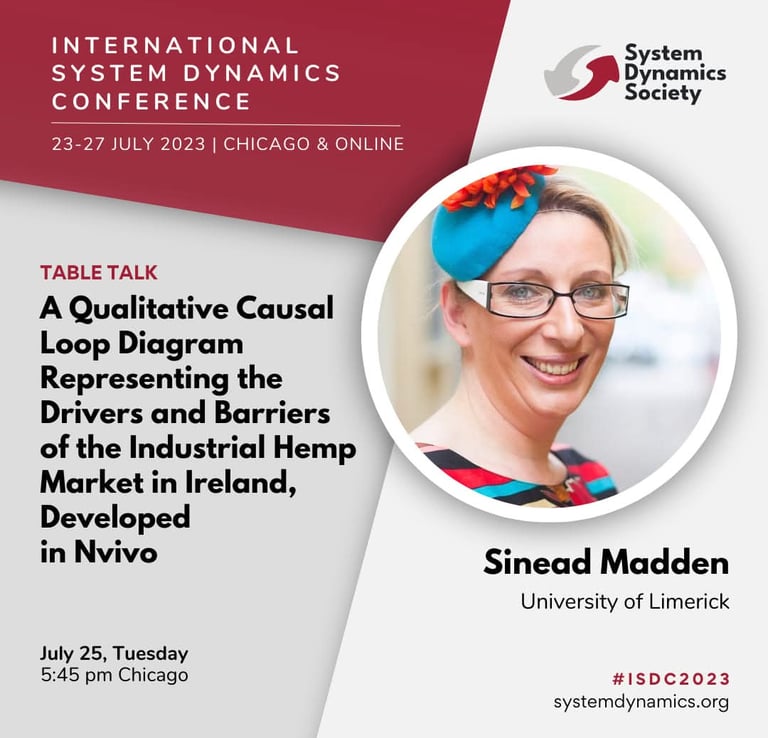

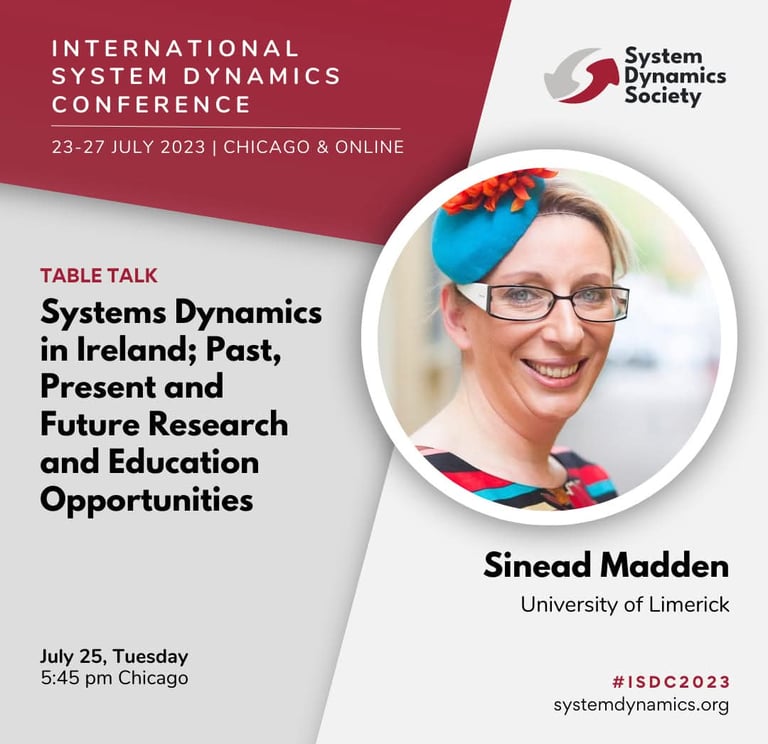

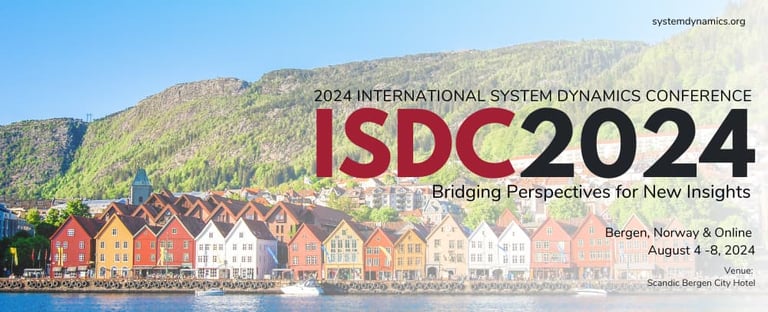

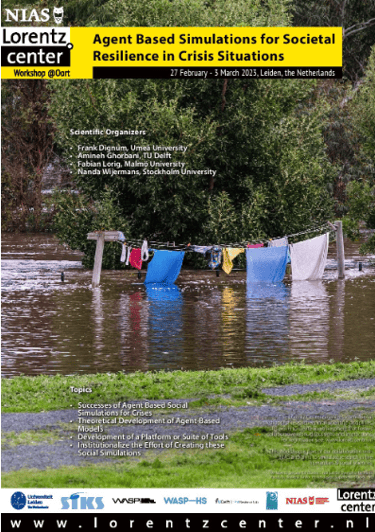

Abstract
This paper outlines the vision and objectives for establishing an Institute for Crisis Modelling (ICM) as a dedicated resilience centre to support policy actors during crises using Agent-Based Social Simulations (ABSS). It emphasises the importance of proactive preparedness for unpredictable, high-impact events, such as pandemics, natural disasters, and economic shocks, where human behaviour plays a critical role in outcomes. The ICM concept brings together a multidisciplinary network of experts, modelling tools, and knowledge resources to enable rapid scenario testing, informed decision-making, and tailored policy interventions. Key objectives include coordinating and advancing ABSS research, fostering sustained and trusted connections with policymakers, maintaining and expanding an expert associate network, ensuring institutional sustainability, and training the next generation of simulation specialists. The paper argues that such an institute would institutionalise ABSS as a valuable, reliable, and accessible method for crisis management, improving both preparedness and resilience at national and international levels.
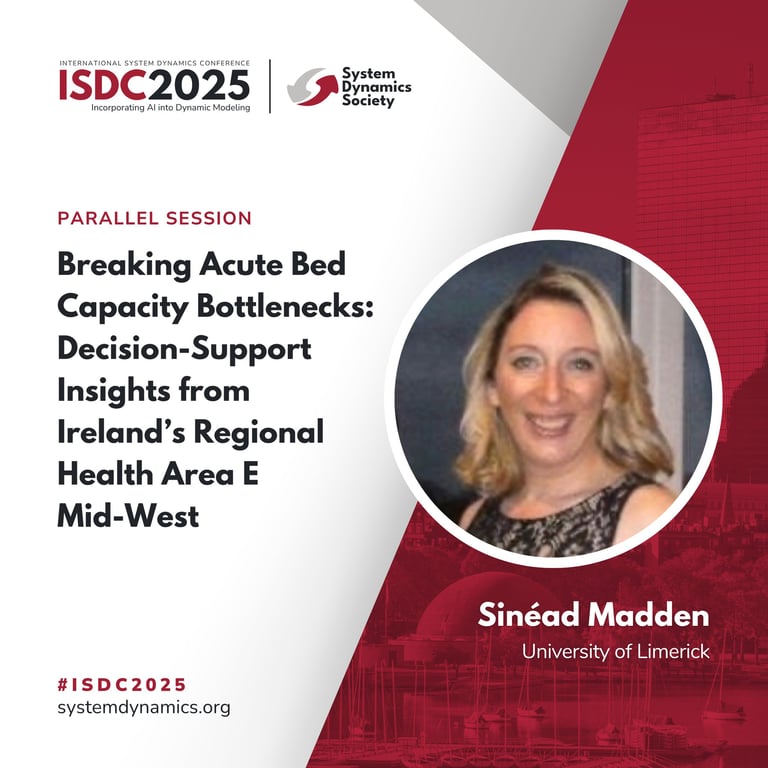

Breaking Acute Bed Capacity Bottlenecks: Decision Support Insights from Ireland’s Regional Health Area (RHA) E Mid-West (MW)
Sinéad M. Madden
Conference paper.
Abstract
Healthcare systems worldwide face persistent bottlenecks in acute care bed capacity driven by rising demand, constrained infrastructure, and systemic delays. In Ireland’s Mid-West (MW) Regional Health Area (RHA) E, the absence of region-specific System Dynamics (SD) models makes it difficult to effectively manage ongoing hospital overcrowding and bed shortages, which continue to drive high trolley numbers and poor patient outcomes. The MIDCARE (Midwest Integrated Demand and Capacity Analysis for Regional Emergency-care) model is a region-specific dynamic simulation framework that captures acute hospital congestion in Ireland’s MW as an emergent behaviour driven by capacity bottlenecks and workforce strain. Through feedback loop analysis and sensitivity testing, the model reveals that infrastructure constraints and consultant shortages are dominant drivers of overcrowding. The model supports evidence-informed interventions, such as redistribution and regional investment, and provides a scalable decision-support tool aligned with Slaintecare, Government of Ireland (GoI) planning priorities. A Causal Loop Diagram highlights reinforcing loops that intensify ED overcrowding and times. Model simulations from 2009 to 2025 mirror observed trends, revealing bed shortages and staffing constraints driving strain, capacity limits, and trolley counts. ED attendances at UHL exceed 60,000 by 2016, signalling critical‑mass inflows that overwhelm beds. Concurrently, Clare’s Local Injuries Unit (LIU) demand rises to 46,704 in 2023, emphasising the necessity of modelling both urgent and non‑urgent care streams. The MIDCARE model offers a new, data-driven way to better understand and tackle hospital capacity issues in Ireland’s MW. To make the model as useful and accurate as possible, policy and decision-makers should participate in a Group Model Building (GMB) workshop to help fine-tune key assumptions and confirm that the model reflects real-world conditions.
Abstract
The area of multi-method hybrid modelling is attracting growing attention because of its ability to gain perspectives from a top-down and bottom-up perspective using System Dynamic (SD) and Agent-Based Modelling (ABM). The original contribution to knowledge is a multi-method hybrid SD and ABM that includes a Geographic Information System (GIS). This study explores hemp’s potential for carbon sequestration in Ireland’s agricultural sector, integrating insights from environmental science, sustainable agriculture, and systems science to address emissions mitigation needs. The study analyses industrial hemp farming adoption dynamics among Irish landowners by combining SD and ABM, leveraging historical data from the Health Products Regulatory Authority (HPRA). Adapting the Bass and Rogers diffusion of innovation models into a hybrid SD-ABM framework programmed in NetLogo using the SD modeller extension, the study offers preliminary insights into hemp farming adoption dynamics, contributing to evidence-based policy-making and advancing hybrid simulation modelling for complex environmental challenges.
Bridging complexity for hybrid perspectives: Modifying the Bass System Dynamic & Rogers Agent-Based Models
Sinéad M. Madden
International Conference of the System Dynamic Society | Bergan | 2024
Conference paper.
Abstract
Farming industrial hemp may aid Ireland in achieving its goal of zero carbon emissions from agriculture by 2050. However, there is a lack of research on industrial hemp in Ireland. This study aims to identify the drivers and barriers affecting the industrial hemp market in Ireland and how applying a Causal Loop Diagram (CLD) can advance our understanding of it. The study used purposive text data from a publicly available transcript to develop a CLD in Vensim. The study found that subsidies and sustainability are the key drivers of the industrial hemp market in Ireland, while negative perceptions of hemp and unsubstantiated claims about its effects are significant barriers. The study demonstrates that it is possible to gain insight into the complexity of Ireland's industrial hemp market by using retrospective analysis of purposive data. The study's framework for developing a CLD can guide future studies in this area. This conceptual model is not meant to be considered complete or accurate, but it serves as a helpful starting point for further research.
A Qualitative Causal Loop Diagram Representing the Drivers and Barriers of the Industrial Hemp Market in Ireland
Sinéad M. Madden
International Conference of the System Dynamics Society | Chicago | 2023
Conference paper.
System Dynamics in Ireland: Past, Present and Future Research and Education Opportunities
Sinéad M. Madden
International Conference of the System Dynamics Society | Chicago | 2023
Conference paper.


An Irish, a Scot, and an English agent walked into a bar. ChatGPT stayed home and adapted the El Farol model to find out why.
Sinéad M. Madden
Social Simulation Conference | Social and Public Health Sciences Unit | University of Glasgow | 2023
Conference Poster
An Institute for Crisis Modelling (ICM) – Towards a resilience center for sustained crisis modeling capability
Fabian Lorig, Bart de Bruin, Melania Borit, Frank Dignum, Bruce Edmonds, Sinéad M. Madden, Mario Paolucci, Nicolas Payette, and Loïs Vanhée
Review of Artificial Societies and Social Simulation.
A systems thinking approach investigating the estimated environmental and economic benefits and limitations of industrial hemp cultivation in Ireland from 2017–2021
Sinéad M. Madden, Alan Ryan, Patrick Walsh
MDPI Agriculture
Journal article | 31-03-2022
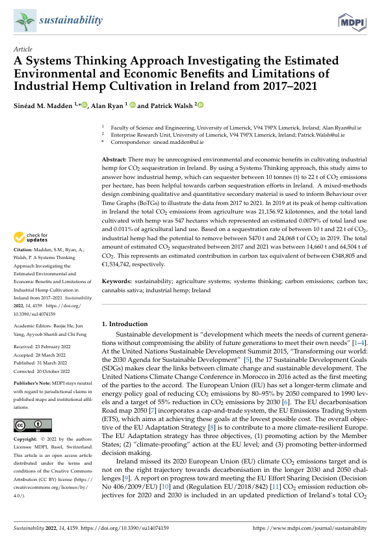

Exploratory study on modelling agricultural carbon emissions in Ireland
Sinéad M. Madden, Alan Ryan, Patrick Walsh
MDPI Agriculture
Journal article | 28-12-2021
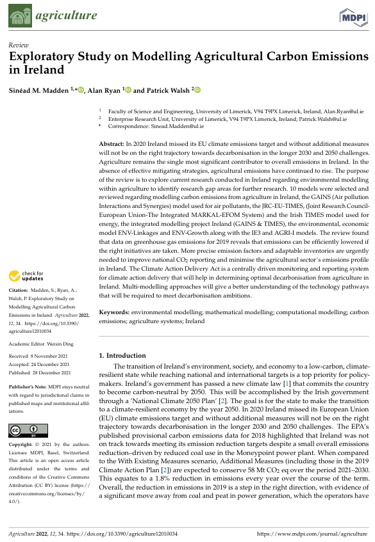

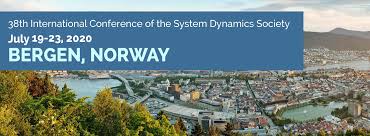

Teagasc & HEMP COOPERATIVE IRELAND
Irish Hemp Event 2022 – Breaking Barriers
A Systems Thinking Approach Investigating the Estimated Environmental and Economic Benefits and Limitations of Industrial Hemp Cultivation in Ireland from 2017–2021
Date: Friday 8th April 2022
Location: Teagasc Ashdown Food Research Centre, Scribblestown, Dublin
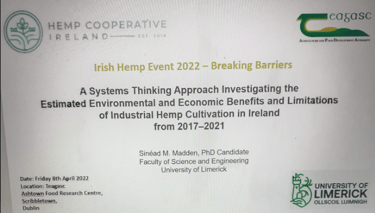

Irish Hemp Event 2022
Socials
Subscribe to our Newsletter
Location
Ennis
County Clare
Ireland
© Copyright 2025 HSML. All rights reserved
Disclaimer: Every effort has been made to ensure the accuracy of the information presented. However, the Hybrid Simulation Modelling Lab (HSML) accepts no responsibility for any loss, damage, or inconvenience arising from errors or omissions. Information is updated regularly, but HSML cannot guarantee its accuracy at any specific point in time. Users seeking to rely on this information should obtain independent confirmation directly from HSML. The outputs presented are developed independently by HSML to advance evidence-based decision-making, with a focus on measurable impact. The contents of MIDCARE (v0.1) are currently under peer review. Findings and interpretations are provisional, subject to revision, and may differ from final published outcomes. No part of this content may be reproduced without prior written consent. Full details of studies and associated simulation data are available upon request.
